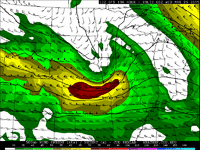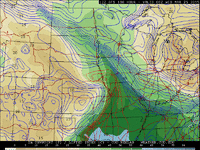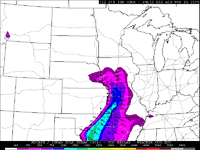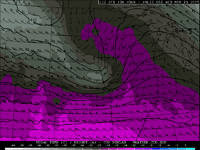Skip Talbot
EF5
...or maybe rename this thread NON-EVENT. Call me a sucker, but I'm looking at the IA/NE/MO corner for a possible cold air event on Tuesday, March 24. I've made the haul out there for setups like this in the past and been burned with just pancake cumulus so I don't know why I keep giving these my consideration. I guess I'm hoping for that surprise IA tornado outbreak that nobody is on because they didn't see it coming, the conditions looked too marginal, or they were all chasing linear crap in the warm sector further south in the jungles.
Here's the deal though.
We've got this real nice negatively tilted trough and shortwave that's been plotted on the GFS the past few runs:

With the height falls, synoptic scale lift, and deepening surface low I'm hoping we're going to see substantial lift here and not get burned again with pancake cu.
Moisture and instability are super marginal:


But here's the catch:

We've got a lobe of really cold air aloft pivoting over the top of that meager moisture axis. That's going to destabilize our warm sector with some really steep lapse rates and could set the stage for some robust updrafts. It's the kind of setup you can get mini supercells with tornadoes out of.
These cold air setups can be super finicky though, and this event might just up and disappear once the NAM is in range. Watch that cold air aloft and the moisture axis closely though. If those come together, we might get a nice little event up there during the afternoon if some heating can melt off the inhibition enough for surface based convection under that cold air aloft.
Here's the deal though.
We've got this real nice negatively tilted trough and shortwave that's been plotted on the GFS the past few runs:

With the height falls, synoptic scale lift, and deepening surface low I'm hoping we're going to see substantial lift here and not get burned again with pancake cu.
Moisture and instability are super marginal:


But here's the catch:

We've got a lobe of really cold air aloft pivoting over the top of that meager moisture axis. That's going to destabilize our warm sector with some really steep lapse rates and could set the stage for some robust updrafts. It's the kind of setup you can get mini supercells with tornadoes out of.
These cold air setups can be super finicky though, and this event might just up and disappear once the NAM is in range. Watch that cold air aloft and the moisture axis closely though. If those come together, we might get a nice little event up there during the afternoon if some heating can melt off the inhibition enough for surface based convection under that cold air aloft.
